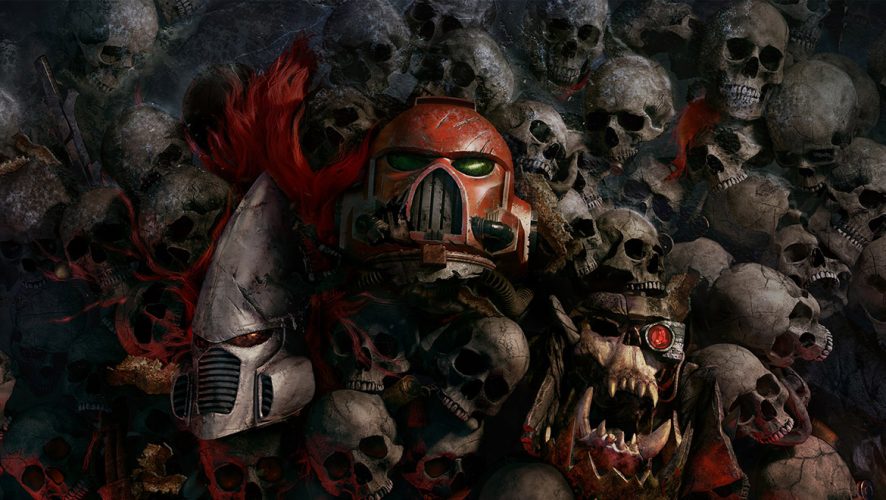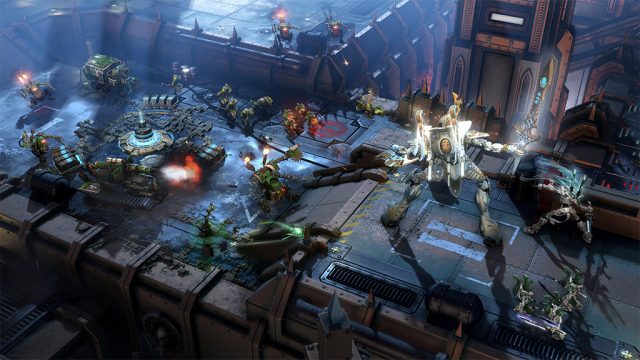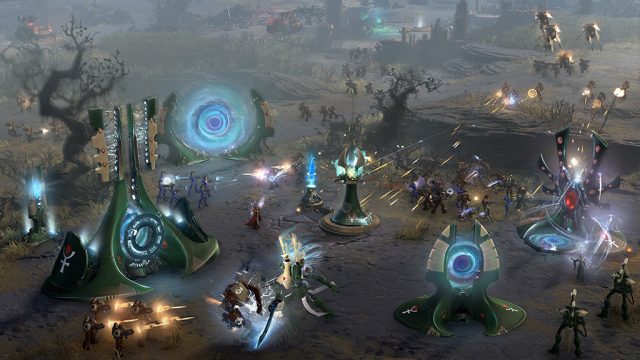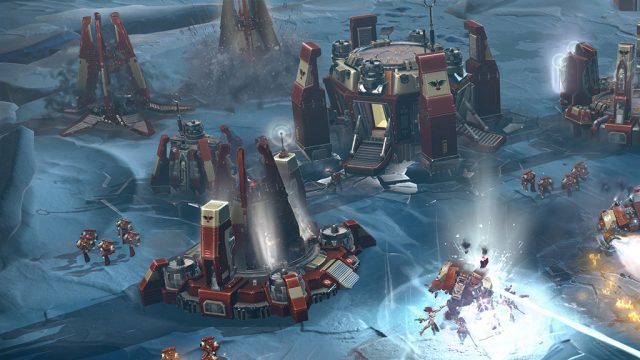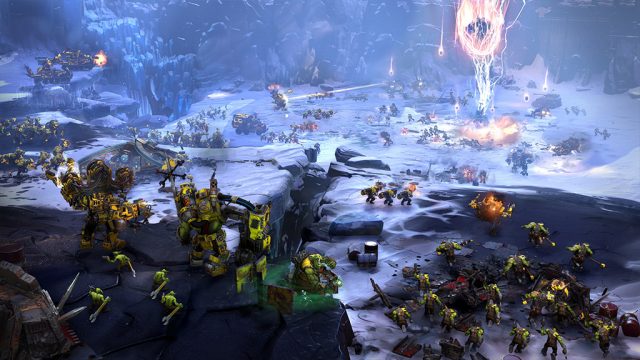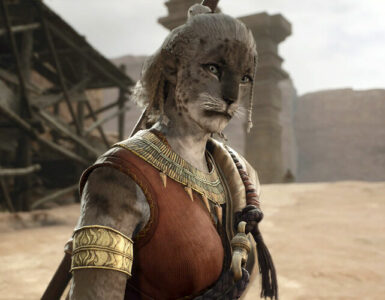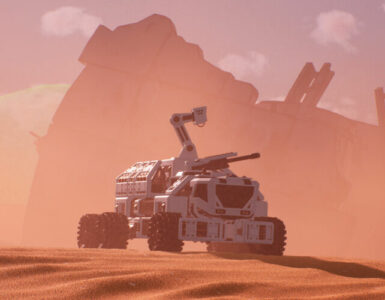Warhammer 40,000: Dawn of War III (DOW3) is a real-time strategy (RTS) game in a genre that hasn’t seen much changes or alternatives in a good long while. Combining massive armies with Elite hero units, it gives players hungry for an alternative RTS title something to check out. Developer Relic Games brings to the table more of their strengths in developing RTS titles, and it shows.
Big guns, even bigger shoulder plates
A quick primer for the uninitiated: Warhammer 40,000 (abbreviated to 40K) and its cousin, Warhammer Fantasy, are what happens if science fiction and fantasy races were not only real, but extremely violent. The entire subgenre of “grimdark” takes its name from 40K’s own tagline, “In the grim dark future, there is only war.”
Here, human Space Marines (nominally the good guys with a religious chip on their shoulders) clash against the futuristic-but-dying Eldar (elves, in space!), push back against the marauding Orks (Barbaric, heavy metal, ramshackle hordes), resist temptation and damnation from literal daemons and demons of Chaos, and more amongst several other factions which will inevitably be added as DLC to DOW3. Getting deep into the lore of the series can be daunting, and fortunately Dawn of War keeps things simpler by scratching just the surface.
Dawn of War 3 ups the ante somewhat by finally introducing Titans to the mix. These twenty-story high behemoths of war usually don’t get played or talked about in the overall lore, so to finally get access to towering Eldar Wraithlords, Ork Deff Dreads and Space Marine Imperial Knights was a real treat.
Not to worry, as what this translates to for DOW3 is that each race has their own specific quirks and faction playstyles. DOW3’s opening features just three right now: The Space Marines, Eldar and Orks. The Space Marines bring a balanced army and then march to victory, the Eldar utilize hit-and-run tactics with regenerating shields (and pitiful hitpoints). The Orks, meanwhile, swarm foes and upgrade themselves with scrap from the battlefield, working troops into a lather with their WAAAAAGHH!! abilities before overwhelming foes.
These unique play styles make for very fun gameplay. The Ork WAAAAGHH!! tower, as one example, is their faction’s primary technology meter: The more they have, the better the stuff they can either build or literally scavenge off the battlefield. It also holds their faction’s unique ability to psych nearby Ork units up (with heavy metal music pounding, Mad Max-esque, from the tower), forcing commanders to place them perilously close to the front lines in order to get maximum use out of the buff.
All this over a scrap of planet
DOW3’s main campaign is, sadly, its weakest link and showcases the worst parts of the game. Where other titles may give players time with a few campaign maps following each faction to allow folks to get a proper feel, DOW3 swaps races each mission. Just as you’re getting a bit of a handle on Space Marines, you’re given Orks in the second and then Eldar in the third mission. This means, for first-timers to the series, that there is little time and explanation of each race’s different playstyle and a constant headache swapping between each.
Functionally, while players will eventually get the hang of each race’s units and playstyle, it means the first few hours of Dawn of War 3’s very micromanagement-heavy playstyle are a chore. Each unit brings their own special abilities to play. Take the Assault squad of Space Marines, for instance, which use their jumpjets to quickly leap into melee range; or the Eldar micromanagement to keep them dancing in and out of fights. You get barely any time to practice and get used to such nuances before being whisked off to a different race.
Now, don’t get me wrong – I love this stuff. Whoosing my Eldar Vyper skimmers from a flank to quickly drop a stasis shield, and then have my Banshee’s scream in for a quick melee kill, is visceral, fun, and pays off. It does, however, need time to get there.
And time is what you need anyway, to get past the somewhat-incomprehensible story. 40K is renowned for the deep and intertwined layers of lore it conjures up, of space knights, doomed planets, massive odds and lots of shooting. DOW3’s story about a prophecy, a doomed planet, and three races vying for it for their own reasons should be classically 40K, but ends up failing mostly due to zapping us between races too much, too fast.
Which is a shame, because Relic has perfectly nailed the over-the-top acting and voice work necessary for a 40K game. The deep baritone of Blood Raven captain Gabriel Angelos, the slightly sneering Farseer Macha, the heavily accented Ork Gorgutz, the punchy sounds of gunfire and chainswords, everything is spot-on. It makes fights feel weighty and powerful, from grunts to hero units.
Rarely, we’ll get a flash of brilliance. In an early Ork mission, your job is to build a massive cannon to take down fortifications with. Except after you’ve built it you realize it’s too humongous to transport easily. Then you fire it. And the kickback from the recoil launches the gun halfway across the map, forming the basis for a new way to bring the gun back to base – keep shooting it while the Eldar are trying to destroy it.
Unfortunately, that’s one of the best of the lot. Maps tend towards railroading players down one (or maybe two) routes to the enemy. Take this building out. Break this position. Yada yada yada. It’s a shame, as maps themselves offer plenty of great RTS wrinkles.
Developer Relic’s control point system, for example, is back in full force. You don’t gain resources through harvesting or set time drops. Instead, scattered throughout the map are resource nodes, which you need to walk troops up to, capture, and then build generators on to slowly climb up resources. These become hotly contested spots in multiplayer, as it’s entirely possible to cripple enemy economies by starving them out. Elegant ebb-and-flow portions of the map become hotly contested sectors to fight out and over, especially with other map wrinkles such as “hard defensive covers” – circular sandbagged areas which, once captured and staffed with troops, provides near-immunity to opposing ranged fire.
This is Brother Angelos, reporting in
We touched on DOW3’s hero units earlier. Called Elites, these are supremely powerful hero units players can summon to the field to swing the tide of battle. As the centerpiece of armies, they single-handedly destroy grunts, making you feel simultaneously powerful and powerless for having built a huge army in the first place.
Take Gabriel Angelos, for instance. Literally standing twice as tall as his fellow marines, he can leap into fights, scattering and instantly smashing weaker troops. Then he’ll swing his hammer, smashing more foes into pulp while also generating a small, short-timed immunity against further ranged fire. Or Farseer Macha, a ranged psyker (think psychic magic) whose abilities revolve around her psychic spear. When her spear is with her, her special abilities revolve around her position; throw it out though, and a stasis field that might be used to save her instead locks down everyone between her and the spear’s point.
Elites are so powerful, and feel so mandatory to the game, that without them armies without an Elite accompaniment will melt against foes with one. It’s not uncommon in the handful of multiplayer games I’ve tried for both armies to be completely decimated, with just Elites left to battle it out.
Alongside Elites are Doctrines. In multiplayer, players can take up to three special doctrines into battle with them. Split into Army, Presence and Command doctrines, each add new tactics. For example, one early-game Doctrine players can access gives Space Marine Dreadnaughts the ability to slam the ground, forming a mini-shield of projectile immunity. This is perfect to help the hulking robot get closer to ranged foes, or stop their fire for a few moments while handling melee troops.
Unlocking more Doctrines and Elites cost Skulls – an in-game currency you’ll earn from levelling up heroes or finishing matches. As an incentive towards keeping players invested in the game, it’s a good middle-ground. There’s enough depth here that multiplayer fans will continually to “get” something every time they play, without seriously imbalancing the game with a pay-to-win moment.
This is my core
Speaking of multiplayer, there’s an interesting change to how maps play out. Besides the already somewhat-unique resource node system, DOW3 features a base defense system for winning. Against other players, you need to progressively take down a shield generator, turret and then the enemy’s power core in order to claim victory.
This is great in theory so far, with my multiplayer matches playing out as massive turnkey fights on such strategic assets and minor skirmishes for resources. On the other, it’s odd given how little emphasis on defense DOW3 places. Besides one or two buildings which can shoot back, there are no real defensive emplacements or uses. Maybe that will change when the Imperial Guard faction gets added?
However, the game also heavily emphasizes attacks. There’s an Escalation timer ticking down right from the get-go, which refunds a part of every lost unit in that phase. Yes, that’s right, you get resources back for free when the timer says it’s time to up the ante. This encourages players to build quicker, smaller armies and get them off to the battlefield, secure in the knowledge that come next phase, we’ll get most of those resources back. It does work to keep players “in the game” and able to come back from early losses, but also means it rewards aggression over a more methodical sort of game.
So beautiful, so slow
That brings us to our final consideration: Graphics. This is a born-and-bred PC title, which means you can crank this baby up to eleven. Dawn of War III, when turned up, is incredibly beautiful and detailed – part of the legacy coming from its miniatures-painting roots. Each Marine is bedecked in their own individual armors, little scriptorium tags on their shoulders or legs. Orks, with their cobbled-together gear, look distinctively individualistic and properly ramshackle.
Yes, the game is beautiful. It’ll also absolutely destroy your system. Once masses of armies gather and begin trading fire, particle effects swimming in stasis fields, dustclouds, rocket fire and more, expect the game to come to a crawling halt. If your system can handle it, it’s absolutely breathtaking. If not, well, you’ll be looking at muddy graphics in order to keep the framerate going.
Closing thoughts
There’s plenty to expect for the future longevity of DOW3. If anything like its predecessors, we can expect Relic to put out actually decent DLC in the form of entirely new races (I look forward to the undead Necrons and rampaging Tyranids), more Elite special units, Doctrines and maps down the road. The company perfected Commander-style gameplay with Company of Heroes 2, and while not perfect, DOW3’s Elite system is ripe for further tweaking to make it just-so.
In the meanwhile we get an RTS that’s fun, punchy, and which hits that sweet spot between being overly micro-manage heavy and “throw my guys against yours” madness.
GEEK REVIEW SCORE
Summary
If you thought you needed a new sort of RTS game and don’t mind over-the-top acting, Dawn Of War 3 delivers with developer Relic’s patented form of fighting.
Overall
8.3/10-
Gameplay - 8/10
8/10
-
Story - 7/10
7/10
-
Presentation - 9/10
9/10
-
Value - 9/10
9/10
User Review
( votes)Practically born with a game in his hands, Jaradcel loves PC, console and handheld gaming but sucks horribly at sports and simulation titles. His secret love is in exploring used game shops and finding well-crafted video game guides to add to his creaking cupboard full of them.

